
The content of this article is organized and released by the editorial department of [China Curtain Wall Network]:
dimming glass is a new type of window energy-saving material. It achieves energy-saving effect by adjusting the solar transmittance. Its principle of action: when the light intensity, temperature, electric field or current used on the dimming glass changes, the performance of the dimming glass will change accordingly, so that high transmittance can be achieved in part or all of the solar spectrum range Reversible change between state and low transmittance state. The dimming glass was originally developed for the automotive industry. Recently, people began to discuss the large-scale standardization of this type of glass and its application in architecture.
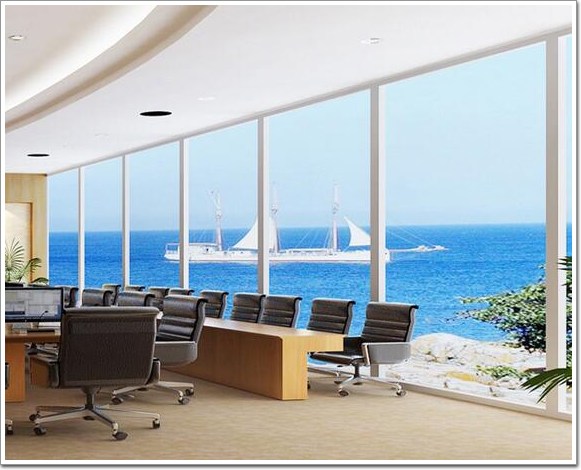
The core of the dimming glass is the color-changing material. According to the different principle of action, the chromic materials can be divided into photochromic, electrochromic, thermochromic and liquid crystal based (1iquid-crystal based). However, only in colorless Only materials with a reversible change between transparent and colored can be used for dimming glass. Light-induced dimming glass is mainly used in the glasses industry. Due to technology, cost and human comfort and other reasons. Its practical value in architectural applications is limited, so this article mainly discusses electro-dimmable glass, thermo-dimmable glass and liquid crystal dimmable glass.
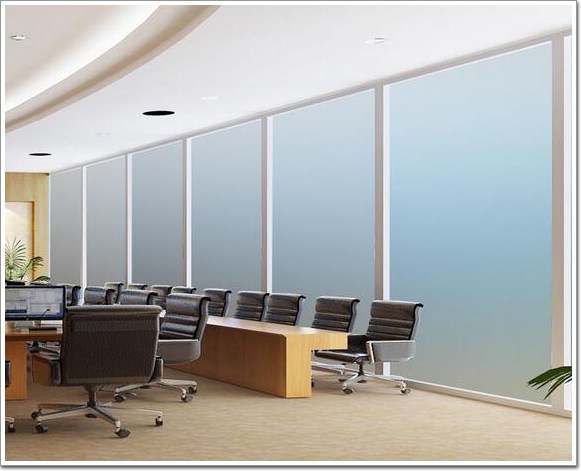
1 Electric dimming glass
1.1 Electrochromic materials and electrochromic principle
"Electrochromic effect" refers to the phenomenon that the transmittance and reflectivity of a material to light can be reversibly changed under the action of an electric field or current. Materials with electrochromic effect are usually called electrochromic materials. According to the discoloration mechanism, electrochromic materials can be divided into three categories: colorless in the oxidized state and colored in the reduced state; colorless in the reduced state and colored in the oxidized state; Multi-color electrochromic materials of different colors. Obviously. The first two materials can be applied to the dimming glass. Electrochromic materials mainly include inorganic transition metal oxides (such as W03, NiO, MoO3, V:0, IrO, etc.) and organic compounds (such as viologen compounds, polyaniline, lanthanide cyanide phthalide, etc.).
About the discoloration mechanism of electrochromic materials. People have reached a more unanimous view, that is, the double-note theory. Discoloration is considered to be caused by the injection or extraction of ions and electrons in the material.
1.2 Structure and working principle of electro-dimmable glass
Electro-dimmable glass is usually composed of ordinary glass and several layers of thin film materials deposited on the glass. The layers are respectively a transparent conductive layer (TC), an electrochromic layer (EC), an ion conductor layer (IC), a counter electrode layer (CE) or an ion storage layer and another transparent conductive layer (TC) in order. The EC layer is the core part of the electro-dimmable glass. The TC layer is used as an extraction electrode, and the CE layer is used to provide and store ions required for color change. The IC layer is used to conduct ions in the process of discoloration, and there is no electronic conduction, otherwise it will self-discharge and cause self-discoloration.
There are two ways to adjust the light of electro-dimmable glass: absorption adjustment and reflection adjustment. Figure 1 shows the spectrum curve of electro-dimmable glass in the colored state and the faded state.
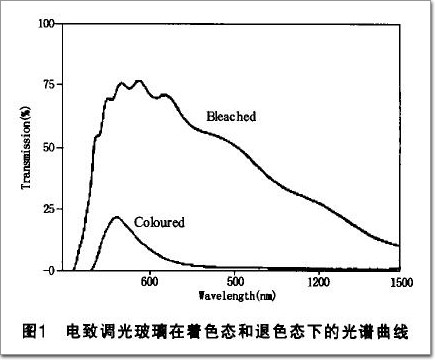
1.3 Research status of electro-dimmable glass
Among the many electrochromic materials, the research of amorphous tungsten oxide, which is a cathodic material, is the most practical. The counter electrode generally adopts another electrochromic material that is complementary to the electrochromic layer, that is, if the color change layer is a cathode electrochromic Material, the anode electrochromic material is used for the counter electrode. Under the action of an external voltage, the cathode and anode will be colored and faded at the same time, so that the color of the colored state is deeper and the light transmittance of the faded state is higher. The typical combination of this complementary discoloration is WO-NiO. WO is colored in the reduced state, and NiO is colored in the oxidized state, so that the discoloration can be deepened. Similarly. When WO is in an oxidized state, NiO is in a reduced state, which can produce glass with high transmittance. The ion conductor layer usually adopts a solid membrane, because although the liquid electrolyte has the advantages of fast response speed and simple production, it also has disadvantages such as difficulty in packaging and liquid leakage, and has no practical value. Li ions are metal ions with the smallest diameter, and their transmission performance is relatively stable. Therefore, ¨ ionic solid conductors have received great attention. LiF, LiA1F4, Li N, LiA1C1 and other ¨Ion conductor films have good performance.
The most used transparent conductive film in electro-switchable glass is indium tin oxide (ITO) and fluorine or ammonium tin oxide (FrO or ATO). For large-sized electro-dimmable glass, the transparent conductive film must have a low sheet resistance to reduce the voltage drop from the edge to the center of the glass. As far as the actual size of the glass window is concerned, the film resistance should be less than 20 m:
2 Thermally dimmable glass
2.1 The working principle of thermal dimming glass
Thermal dimming glass is usually composed of a layer of reversible thermochromic material coated on ordinary glass. After decades of research and development, people have developed various reversible thermochromic materials such as inorganic, organic, polymer and biological macromolecules. However, for dimming glass, the discoloration temperature must be in the low temperature region to have practical value. Among many reversible thermochromic materials, thin-film coatings based on vanadium oxides are a hot research topic. Among them, VO is the most interesting oxide, because its phase transition temperature (q'C) is 68°C, which is of great significance in practical applications. When the temperature is lower than 68℃, VO has a monoclinic crystal structure; when the temperature is higher than 68℃, it has a tetragonal crystal structure. Due to the change of the crystal structure, the optical properties of VO have undergone great changes, and this change is reversible. Figure 3 shows the changes in the transmittance and reflectance of the VO film in the solar spectrum before and after the phase transition.
The prerequisite for the practical application of VO thin film is to reduce its phase transition temperature from 68°C to close to room temperature. Experiments have confirmed that the phase transition temperature varies with the preparation method and process of the film. In addition, doping technology, fluorination technology or methods to reduce surface stress can also be used to reduce the phase transition temperature of the film. Commonly used doping elements are niobium, molybdenum, tungsten and so on. F.C.Case coated a VO film with a phase transition temperature of 38℃ by doping with 0.9% tungsten.
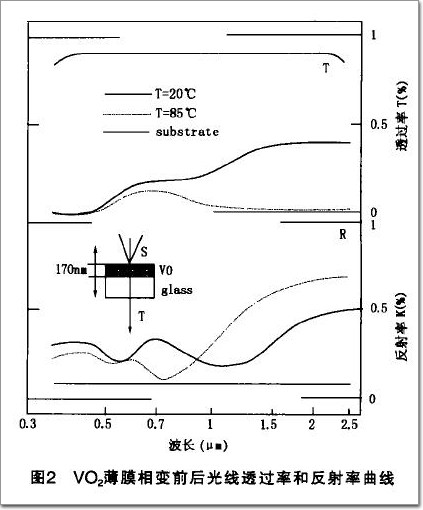
2.2 New progress in the research of thermo-switchable glass
For many years, people have been committed to the research and development of low-temperature thermo-dimmable glass, and have achieved gratifying results. The United States, Germany, Britain and other countries have successively developed a new type of low-temperature (20℃~50℃) thermal dimming material. This new type of thermo-dimmable material contains at least two substances with different refraction coefficients. When the temperature is low, these substances are mixed at the molecular level by intermolecular forces to achieve a homogeneous phase. At this time, the material is transparent: as the temperature rises, the molecular thermal motion intensifies, and when the temperature rises to a certain value , The phase separation occurs, and countless fine particles are formed. The incident light is strongly scattered, because most of the light is diffusely reflected, so the material becomes opaque white at this time.
This new type of thermal dimming material can be divided into two types, one is cloud glue (hydrogel), and the other is a mixture of polymers. Sealing the cloud glue in the glass interlayer can be made into thermal dimming glass, and the made dimming glass has attracted people's attention because of its good optical performance and fast response speed. Cloud glue is a homogeneous cross-linked gel formed by water and a polymer at low temperature. When the temperature rises to a certain value, cloud glue will phase separate. The polymer components form countless sizes and incident light wavelengths. The equivalent particles scatter incident light, see Figure 3.
Japan's Fuji XEROX company analyzed and imitated the color change mechanism of cephalopods such as squid and octopus and developed a pigment. Wrap a high concentration of pigment in a polymer gel particle, under normal temperature, light passes through; when the temperature rises, the volume of the polymer gel wrapped with the pigment expands by about 30 times, thus shielding the sunlight.
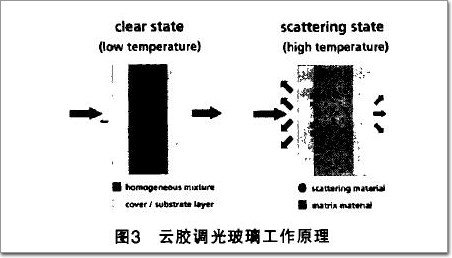
3 LCD dimming glass
3.1 The structure of liquid crystal dimming glass
Liquid crystal dimming glass is a new type of glass made according to the orderly arrangement characteristics of liquid crystal under the action of electric field. Its basic structure is shown in Figure 4. The liquid crystal or a mixture of liquid crystal and plastic is encapsulated in resin, and both sides are lined with tape The LB polarizing film with a transparent conductive film is then packaged between two pieces of glass to make a liquid crystal dimming glass.
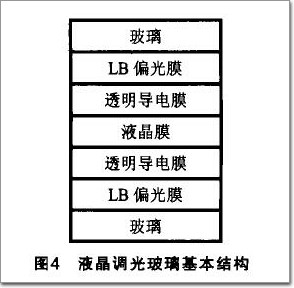
3.2 The working principle of LCD dimming glass
The liquid crystal molecules are arranged disorderly before being energized, which can spread the parallel light, that is, the opaque state: After the power is on, the liquid crystal molecules are arranged in one direction, so that the parallel light can pass through, that is, the transparent state. The liquid crystal is sealed in the resin, even if the glass is broken, the liquid crystal will not flow out, and the safety is better.
3.3 Problems faced by the LCD dimming glass research institute
From the perspective of industrial development, the contents that need to be studied are: (1) Development of liquid crystal materials with long life, fast response speed, low voltage and low price; (2) Resin packaging technology, which requires the resin to be transparent and does not damage the liquid crystal (3) The process characteristics of the polarizing film, looking for a polarizing film that is easy to obtain, has good light transmittance and does not require high environmental requirements.
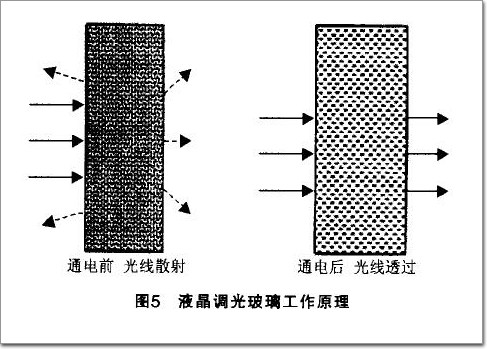
4 Conclusion
A study by the American SERI Institute shows that dimming glass can reduce the energy consumption of air conditioning in buildings by about 25%, and at the same time, it can also play a decorative role. It can also reduce indoor and outdoor shading facilities, such as curtains and blinds. And other equipment costs. It is precisely because of so many advantages that the United States, Japan, Europe and other countries and regions have successively formulated plans and invested a lot of manpower and financial resources in research on dimming glass. The world dimming glass market is also expanding year by year, reaching 200 billion yen in 2000. In terms of dimming glass research, Japan and the United States are in a leading position in the world. my country's research in this area started late and the level is relatively backward. We should learn from foreign research experience to promote the development of my country's dimming glass research.
First-hand information on doors, windows and curtain walls! Go to China Curtain Wall.com news.alwindoor.com Mobile access address 3g.alwindoor.com
Original address: http://www.52mqw.com/info/2016-12-12/42133-1.htm
Please indicate the source when reprinting: China Curtain Wall Network Click to view www.alwindoor.com